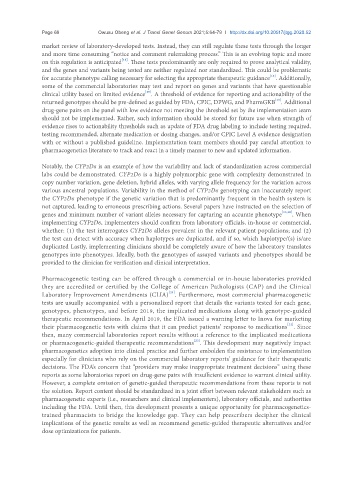Page 90 - Read Online
P. 90
Page 68 Owusu Obeng et al. J Transl Genet Genom 2021;5:64-79 I http://dx.doi.org/10.20517/jtgg.2020.52
market review of laboratory-developed tests. Instead, they can still regulate these tests through the longer
and more time consuming “notice and comment rulemaking process.” This is an evolving topic and more
[18]
on this regulation is anticipated . These tests predominantly are only required to prove analytical validity,
and the genes and variants being tested are neither regulated nor standardized. This could be problematic
[15]
for accurate phenotype calling necessary for selecting the appropriate therapeutic guidance . Additionally,
some of the commercial laboratories may test and report on genes and variants that have questionable
[19]
clinical utility based on limited evidence . A threshold of evidence for reporting and actionability of the
returned genotypes should be pre-defined as guided by FDA, CPIC, DPWG, and PharmGKB . Additional
[15]
drug-gene pairs on the panel with low evidence not meeting the threshold set by the implementation team
should not be implemented. Rather, such information should be stored for future use when strength of
evidence rises to actionability thresholds such as update of FDA drug labeling to include testing required,
testing recommended, alternate medication or dosing changes, and/or CPIC Level A evidence designation
with or without a published guideline. Implementation team members should pay careful attention to
pharmacogenetics literature to track and react in a timely manner to new and updated information.
Notably, the CYP2D6 is an example of how the variability and lack of standardization across commercial
labs could be demonstrated. CYP2D6 is a highly polymorphic gene with complexity demonstrated in
copy number variation, gene deletion, hybrid alleles, with varying allele frequency for the variation across
various ancestral populations. Variability in the method of CYP2D6 genotyping can inaccurately report
the CYP2D6 phenotype if the genetic variation that is predominantly frequent in the health system is
not captured, leading to erroneous prescribing actions. Several papers have instructed on the selection of
genes and minimum number of variant alleles necessary for capturing an accurate phenotype [15,20] . When
implementing CYP2D6, implementers should confirm from laboratory officials, in-house or commercial,
whether: (1) the test interrogates CYP2D6 alleles prevalent in the relevant patient populations; and (2)
the test can detect with accuracy when haplotypes are duplicated, and if so, which haplotype/(s) is/are
duplicated Lastly, implementing clinicians should be completely aware of how the laboratory translates
genotypes into phenotypes. Ideally, both the genotypes of assayed variants and phenotypes should be
provided to the clinician for verification and clinical interpretation.
Pharmacogenetic testing can be offered through a commercial or in-house laboratories provided
they are accredited or certified by the College of American Pathologists (CAP) and the Clinical
Laboratory Improvement Amendments (CLIA) . Furthermore, most commercial pharmacogenetic
[21]
tests are usually accompanied with a personalized report that details the variants tested for each gene,
genotypes, phenotypes, and before 2019, the implicated medications along with genotype-guided
therapeutic recommendations. In April 2019, the FDA issued a warning letter to Inova for marketing
their pharmacogenetic tests with claims that it can predict patients’ response to medications . Since
[22]
then, many commercial laboratories report results without a reference to the implicated medications
or pharmacogenetic-guided therapeutic recommendations . This development may negatively impact
[23]
pharmacogenetics adoption into clinical practice and further embolden the resistance to implementation
especially for clinicians who rely on the commercial laboratory reports’ guidance for their therapeutic
decisions. The FDA’s concern that “providers may make inappropriate treatment decisions” using these
reports as some laboratories report on drug-gene pairs with insufficient evidence to warrant clinical utility.
However, a complete omission of genetic-guided therapeutic recommendations from these reports is not
the solution. Report content should be standardized in a joint effort between relevant stakeholders such as
pharmacogenetic experts (i.e., researchers and clinical implementers), laboratory officials, and authorities
including the FDA. Until then, this development presents a unique opportunity for pharmacogenetics-
trained pharmacists to bridge the knowledge gap. They can help prescribers decipher the clinical
implications of the genetic results as well as recommend genetic-guided therapeutic alternatives and/or
dose optimizations for patients.

